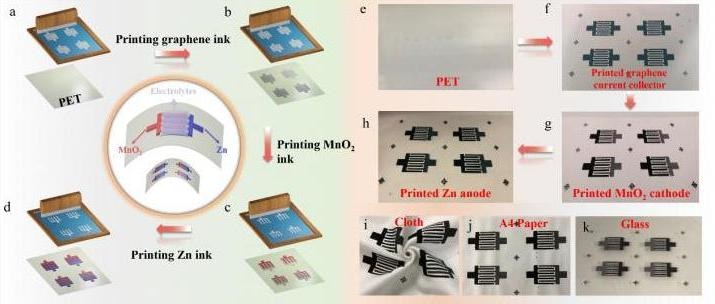Jul 10 2019
Growing development of micro-scale electronics has urged the need for related micro-scale power sources, particularly for micro-batteries (MBs). Poor flexibility and complicated manufacturing process of the conventional stacked batteries, however, have prevented their practical applications.
 (a-d) Schematic of screen printing fabrication of printed Zn//MnO2 MBs: (a) the black PET substrate, (b) the printed graphene current collectors, (c) the printed MnO2 cathode, and (d) the printed Zn anode. (e-h) Optical photographs showing the stepwise printing fabrication of Zn//MnO2 MBs: (e) the black PET substrate, (f) the graphene current collectors, (g) the printed MnO2 cathode, and (h) the printed Zn anode on the interdigital graphene fingers. (i-k) Zn//MnO2 MBs printed onto the different substrates, including (i) cloth, (j) A4 paper, and (k) glass. (Image credit: Science China Press)
(a-d) Schematic of screen printing fabrication of printed Zn//MnO2 MBs: (a) the black PET substrate, (b) the printed graphene current collectors, (c) the printed MnO2 cathode, and (d) the printed Zn anode. (e-h) Optical photographs showing the stepwise printing fabrication of Zn//MnO2 MBs: (e) the black PET substrate, (f) the graphene current collectors, (g) the printed MnO2 cathode, and (h) the printed Zn anode on the interdigital graphene fingers. (i-k) Zn//MnO2 MBs printed onto the different substrates, including (i) cloth, (j) A4 paper, and (k) glass. (Image credit: Science China Press)
Recently, planar MBs have gained considerable attention owing to their facile serial/parallel integration, simple miniaturization, and potential to work without the need for separator membranes. Moreover, planar geometry has very short ion diffusion pathway due to the complete integration of printed electronics on an individual substrate.
In addition, to eliminate the safety issues caused by the flammable organic electrolyte, the aqueous electrolyte, which has high ionic conductivity, intrinsic nonflammability, and nontoxicity, is an excellent candidate for large-scale wearable and flexible MB applications. Consequently, different printing techniques have been used for producing planar aqueous MBs.
In particular, screen printing can effectively control the precise pattern design with adjustable rheology of the inks, and is very promising for large-scale application.
Zhong-Shuai Wu, Dalian Institute of Chemical Physics, Chinese Academy of Sciences
In a new study reported in National Science Review, a Beijing-based journal, Zhong-Shuai Wu from the Dalian Institute of Chemical Physics, Chinese Academy of Sciences, used relevant and economic screen printing method to fabricate aqueous rechargeable planar Zn//MnO2 batteries.
He remarked that “The planar Zn//MnO2 micro-batteries, free of separators, were manufactured by directly printing the zinc ink as the anode and γ-MnO2 ink as the cathode, high-quality graphene ink as metal-free current collectors, working in environmentally benign neutral aqueous electrolytes of 2 M ZnSO4 and 0.5 M MnSO4.”
The production of Zn//MnO2 MBs of various shapes onto different substrates suggests their possible extensive applications.
When analyzed in neutral aqueous electrolyte, the planar separator-free Zn//MnO2 MBs exhibited high volumetric capacity of 19.3 mAh/cm3 (equivalent to 393 mAh/g), at 7.5 mA/cm3, and striking volumetric energy density of 17.3 mWh/cm3, surpassing lithium thin-film batteries (≤10 mWh/cm3).
Furthermore, the Zn//MnO2 planar MBs exhibit long-term cyclability, maintaining high capacity retention of 83.9% after 1300 times at 5 °C, better than stacked Zn//MnO2 MBs reported. The Zn//MnO2 planar MBs also show outstanding flexibility without observable capacity decay under severe deformation and astonishing serial and parallel integration of constructing bipolar cells with high voltage and capacity output.
This acceptable outcome will pave the way for many intriguing opportunities in several applications of printed, intelligent, and miniaturized electronics.
This study will also stimulate researchers working in chemistry, material science, nanotechnology, and energy storage and may have considerable influence on both future technological development of planar micro-scale energy-storage devices and study of graphene-based materials.